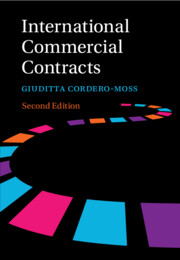540 results
Chapter Four - US Litigation by Chinese Companies
-
- Book:
- Negotiating Legality
- Print publication:
- 27 June 2024, pp 124-158
-
- Chapter
- Export citation
4 - War, Peace and Interstate Relations
-
-
- Book:
- The Cambridge Comparative History of Ancient Law
- Published online:
- 09 May 2024
- Print publication:
- 30 May 2024, pp 146-180
-
- Chapter
- Export citation
40 - Decision-Making in Alternative Dispute Resolution
- from Part V - Other Legal Decision-Making
-
-
- Book:
- The Cambridge Handbook of Psychology and Legal Decision-Making
- Published online:
- 22 February 2024
- Print publication:
- 29 February 2024, pp 617-633
-
- Chapter
- Export citation
2 - The Role of Transnational Law
-
- Book:
- International Commercial Contracts
- Published online:
- 09 November 2023
- Print publication:
- 01 February 2024, pp 39-134
-
- Chapter
- Export citation
5 - Does Arbitration Ensure a Self-Sufficient Contract?
-
- Book:
- International Commercial Contracts
- Published online:
- 09 November 2023
- Print publication:
- 01 February 2024, pp 285-440
-
- Chapter
- Export citation
1 - International Contract Practice and Its Expectations in Terms of the Governing Law
-
- Book:
- International Commercial Contracts
- Published online:
- 09 November 2023
- Print publication:
- 01 February 2024, pp 8-38
-
- Chapter
- Export citation
4 - Which State’s Law Governs an International Contract?
-
- Book:
- International Commercial Contracts
- Published online:
- 09 November 2023
- Print publication:
- 01 February 2024, pp 200-284
-
- Chapter
- Export citation
3 - That Sweet Enmity
-
- Book:
- Athens and Boiotia
- Published online:
- 29 February 2024
- Print publication:
- 25 January 2024, pp 73-171
-
- Chapter
-
- You have access
- Open access
- HTML
- Export citation
17 - International Dispute Settlement
- from Part III - New Opportunities and the Future of International Dispute Settlement
-
-
- Book:
- The Changing Character of International Dispute Settlement
- Published online:
- 14 December 2023
- Print publication:
- 21 December 2023, pp 497-516
-
- Chapter
- Export citation
9 - Coherence, Consistency, and the Reform of Investment Treaty Arbitration
- from Part II - Effectiveness, Authority, and Legitimacy of the Current System of International Dispute Settlement and Possible Reforms
-
-
- Book:
- The Changing Character of International Dispute Settlement
- Published online:
- 14 December 2023
- Print publication:
- 21 December 2023, pp 249-281
-
- Chapter
- Export citation
15 - Autonomy in International Law
- from Part III - Subjects and Institutions of Consent
-
-
- Book:
- Consenting to International Law
- Published online:
- 23 November 2023
- Print publication:
- 07 December 2023, pp 347-368
-
- Chapter
- Export citation
Chapter 9 - ‘A Final Peax’: Passing Judgment
- from Part III - Delivering and Contesting Justice
-
- Book:
- Royal Justice and the Making of the Tudor Commonwealth, 1485–1547
- Published online:
- 02 November 2023
- Print publication:
- 16 November 2023, pp 224-253
-
- Chapter
- Export citation
Chapter 5 - Disputes and Dispute Resolution
- from Part II - Seeking and Requesting Justice
-
- Book:
- Royal Justice and the Making of the Tudor Commonwealth, 1485–1547
- Published online:
- 02 November 2023
- Print publication:
- 16 November 2023, pp 117-141
-
- Chapter
- Export citation

International Commercial Contracts
- Contract Terms, Applicable Law and Arbitration
-
- Published online:
- 09 November 2023
- Print publication:
- 01 February 2024
8 - International Courts and Tribunals
- from Part I - The Structure of International Law
-
- Book:
- International Law
- Published online:
- 19 October 2023
- Print publication:
- 02 November 2023, pp 153-179
-
- Chapter
- Export citation
The Negotiation, Diffusion, and Legacy of NAFTA Chapter 11: An Empirical Eulogy
-
- Journal:
- Canadian Yearbook of International Law / Annuaire canadien de droit international / Volume 60 / November 2023
- Published online by Cambridge University Press:
- 19 October 2023, pp. 137-176
- Print publication:
- November 2023
-
- Article
-
- You have access
- Open access
- HTML
- Export citation
11 - Enforcement of International Humanitarian Law
-
- Book:
- International Humanitarian Law
- Published online:
- 24 August 2023
- Print publication:
- 07 September 2023, pp 330-400
-
- Chapter
- Export citation
Labour alternative dispute resolution modes in Zimbabwe
-
- Journal:
- The Economic and Labour Relations Review / Volume 34 / Issue 3 / September 2023
- Published online by Cambridge University Press:
- 24 August 2023, pp. 555-571
-
- Article
-
- You have access
- Open access
- HTML
- Export citation
10 - Third-Party Peacemaking and Peacekeeping
- from Part IV - Diplomacy and Conflict
-
-
- Book:
- Understanding War and Peace
- Published online:
- 06 July 2023
- Print publication:
- 20 July 2023, pp 300-336
-
- Chapter
- Export citation
6 - Defending the State in ISDS and Preventing Disputes
- from Part II - Formal and Informal Institutional Effects of Investment Treaties on National Governance
-
- Book:
- National Governance and Investment Treaties
- Published online:
- 29 June 2023
- Print publication:
- 13 April 2023, pp 186-226
-
- Chapter
- Export citation



